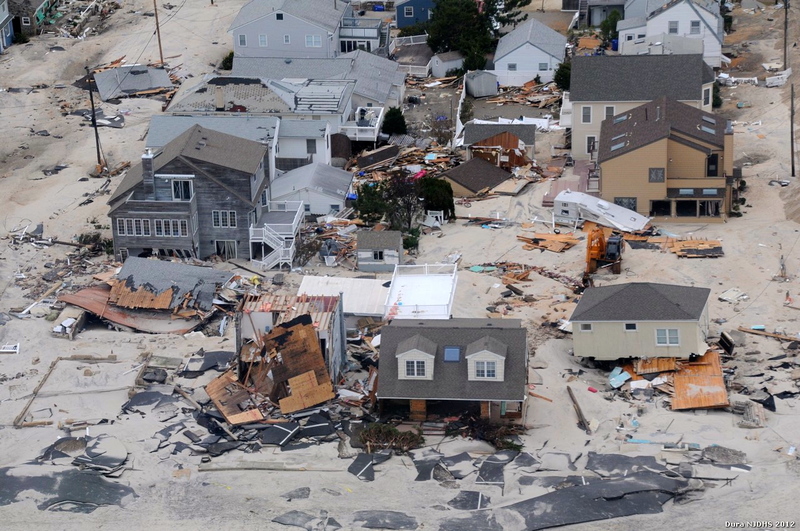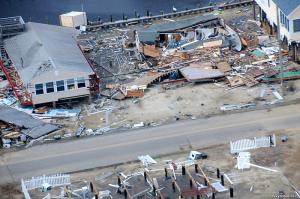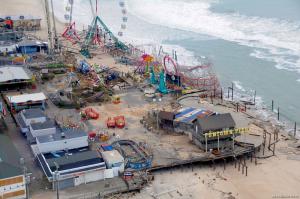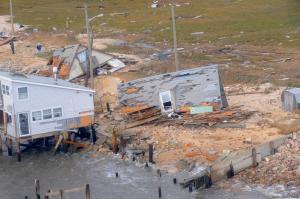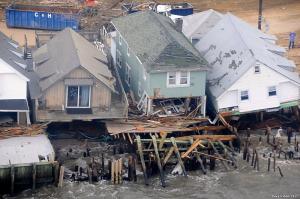New Jersey emergency manager Dennis Dura said last year, he was breathing a sigh of relief in mid-October. “We've made it through another hurricane season,” he thought to himself.
He was wrong. In less than two weeks, on Oct. 24, he was looking at meteorological models showing a possible direct hit by then Tropical Storm Sandy in the Mid-Atlantic region. “But at that point there was reluctance and doubt that it would not happen here, and that it would turn out to sea,” he said during a July 31 presentation to the Delmarva Emergency Task Force at the Carvel Research Center in Georgetown.
The storm intensified and pummeled the New Jersey coast Oct. 29, leaving behind a path of death and destruction – and it also revealed gaps in emergency preparedness plans.
“We never had a good handle on what was going on,” he said. “We were reacting as opposed to being proactive. We were firefighting all the time.”
More than 80 people died in New Jersey, a number, Dura said, that has been under-reported by the media.
Communicating with residents was nearly impossible, as one of the main issues faced by New Jersey emergency officials. During the storm and in the first days after, as many as 3 million people were without electricity – so getting the word out to residents was extremely difficult, Dura said.
“Using social media is a great idea, but if cell phones are down or not charged, messages are going into a black hole,” he said.
In the aftermath of Sandy, Dura said, communication between towns, counties and the state was another major issue as officials scrambled to get emergency supplies. “It was as if the feeding trough opened up and everyone wanted stuff,” he said. “Some mayors were calling the White House and their senators directly to get what they needed.”
He said he hoped the lessons learned by emergency officials in New Jersey would help those on Delmarva. “I could talk all day about the people issues we experienced,” he said.
Dura said emergency officials in New Jersey have a new awareness. “You have to think, prepare and act like a hurricane state,” he said.
Dura is assistant director of the New Jersey Department of Human Services in the Office of Emergency Management.
Providing shelters to evacuees
One of the key areas where deficiencies were most acute, Dura said, was sheltering evacuees. He said to this day, they are not positive how many people were in shelters. “The best estimate is around 21,000,” he said.
None of the designated shelters had a generator, although some shelters were moved to locations with generators, Dura said.
Dura said coastal New Jersey has no shelter that would survive a Category 2 hurricane. Residents would have to be moved to Pennsylvania or even Ohio. “We could not safety shelter people in New Jersey,” he said.
Under a revised shelter plan, the state now has more than 75 shelters designed to withstand a Category 1 hurricane to house as many as 24,000 people.
Shelters were opened two days before landfall, and state shelters closed a week before Thanksgiving. But that doesn't mean everyone left shelters. Because of the extent of the damage along the coast, many people were placed in hotels or in other facilities under a long-term FEMA sheltering program. They simply had no other place to go.
As late as May, some people were still housed in hotels. “People were getting comfortable in their shelters and some didn't want to leave,” he said.
In some cases, people in shelters were showered with donations from well-meaning agencies, churches and individuals. “One particular family had to rent a truck to haul out all of the donations they received,” Dura said.
Contrary to what most might think, feeding people was less problematic, thanks in a big part to outside groups – such as Southern Baptists with mobile field kitchens – who came in after the storm moved through. “But we didn't have prepared locations for them, and we didn't have enough propane or a way to transport it,” he said.
Those were problems, emergency officials had to solve. In the end, Dura said, more than 1 million meals were served.
Dura said shelter workers were faced with unexpected consequences. Because area hospitals were overwhelmed, patients – including some patients with mental illnesses – were discharged without medication. In addition, some evacuees were told they could not bring oxygen or their prescriptions to shelters.
Airports closed quickly as the storm arrived, and because the storm hit on Sunday night into Monday, national aid workers had no way to respond to the area. Shelters were opened with few volunteers who were quickly overwhelmed, Dura said. “The crush brought down our whole system,” he said.
Ocean County, ground zero of the storm, has the highest concentration of residents 85 years of age and older in the United States, Dura said. “We didn't have staff to address their specific needs, so we had to divert people from other areas,” he said.
Seemingly small things, compared to the scope of events – such as showers and pets – can sometimes become major stumbling blocks, Dura said.
The entire area was served by one trailer equipped with showers. “That was one of our biggest resource needs. If I had some of those trailers, I could have been a billionaire,” he said. He said the state now has two shower trailers.
Sheltering people with their pets became an issue without a solution, Dura said, adding it's something emergency planners should take into consideration. New Jersey officials opened one shelter to accept people and their pets, but too many other people also showed up to use the shelter. “We will never do it again. It was a good idea in theory, but too many non-pet owners showed up,” he said.
They also ran into issues with shelters at schools. “They had shelter fatigue and wanted us out as quickly as possible,” he said.
Dura said there were about 10,000 people that no one could account for. As it turned out, many rode out the storm together as part of ethnic communities.
Dura said despite the shelter issues, no one died or was seriously injured in a shelter.
Now known as Superstorm Sandy, the hurricane caused $68 billion in damage – second only to Hurricane Katrina – and killed at least 286 people in seven countries. It is also the largest hurricane ever recorded, with a wind field spreading out 1,100 miles.
Next week: Is Delaware prepared?














